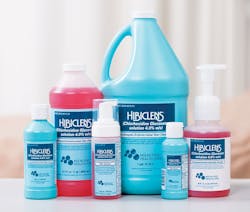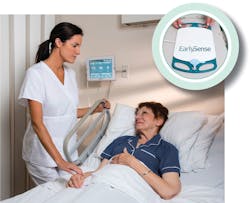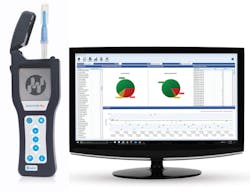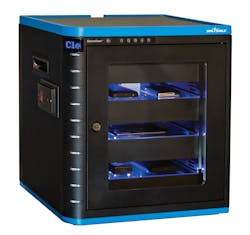What makes a medical operation worth watching? Gains over infection, winning the battle. The gains don’t have to be large to be significant. Even a small gain means someone did not suffer from or die of a hospital-acquired infection (HAI). Preservation of even one life is worth celebrating.
Below are stories of infection-prevention operations worth watching. Some of the facilities do not want to be identified, often because they feel it is bad press for it to be known that they needed to improve their infection rates. That is a shame, because they are in good company. Many hospitals need to improve their infection rates, but that does not mean they are not doing their job conscientiously. It often just means a tweak in best practice or a switch in product is needed. Whether the facility is named or not, hats off to their efforts to improve patient safety.
Maine General tackles SSIs
A report in JAMA1 noted that, because the number of surgical procedures is rising in the U.S., it is critical to prevent surgical-site infections (SSIs). In addition to considering patient safety, the study stated, “. . . reporting of process, outcome, and other quality improvement measures is now required, and reimbursements for treating SSIs are being reduced or denied. It has been estimated that approximately half of SSIs are preventable by application of evidence-based strategies.”
Tracey Shaw, MT (ASCP), CIC, Mölnlycke, nominated Maine General Medical Center as an operation worth watching. Shaw related, “Data analysis showed a spike in superficial SSIs among Cesarean-section patients between January and July 2017 at Maine General Medical Center. This spike was addressed with a focused postoperative infection-reduction strategy implementation.” Shaw said the C-section SSI rates were lowered by an astounding 65 percent over eight months.
Shaw explains the steps that brought them to this result. “Strategies currently in place in the operating room and C-section delivery rooms for SSI prevention include pre-operative antibiotic administration, hair removal when appropriate, adherence to the Association of periOperative Registered Nurses (AORN) standard for surgical attire, intraoperative skin antisepsis with an alcohol/chlorhexidine product, maintaining traffic control during procedures, and monitoring hand hygiene. Multiple closure methods are used by surgeons. All surgeons routinely used sterile gauze for the dressing.”
A vital step was to investigate possible causes of the spike in infection. “The root cause uncovered that, upon discharge, patients were instructed to remove the gauze dressing at home.” Despite being discharged with written and verbal instructions on wound care and signs of infection, “surgeons noted that the wound-care instructions were not often followed, and the same dressing was still in place at the two-week post-op visit,” said Shaw.
Shaw concluded, “A multidisciplinary team, including infection prevention along with a surgeon champion, worked to update patient infection-reduction strategies and increase the post-operative education provided to patients. All protocol changes were incorporated into the electronic medical record, and staff were instructed to document that patient education was given and that a bottle of Hibiclens four-percent foam was provided.”
It is amazing what a simple change in protocol and adoption of an inexpensive, easy-to-use product achieved in terms of infection reduction.
Ohio Hospital strives to rid sepsis
The Centers for Disease Control and Prevention (CDC) said that 1.7 million adults in America develop sepsis, with nearly 270,000 Americans dying as a result of sepsis. One in three patients who die in a hospital have sepsis.2 Those are some serious numbers. The good news is that, with rapid diagnosis and treatment, about 80 percent of sepsis-related deaths can be prevented.2
Sepsis is also costly to treat. Todd Barnett, Director of Government and Strategic Accounts, EarlySense pointed out that sepsis has been named as the most expensive in-patient cost in American hospitals.3 “More people die from sepsis than breast, prostate, and lung cancers combined,” said Barnett.
In 2015, a hospital that prefers anonymity had a mortality rate of 27.1 percent, which is above the statewide average of 19.4 percent. Barnett said the hospital joined the Ohio Hospital Association’s Institute for Health Innovation and the Sepsis Alliance to help reduce the number of sepsis-related deaths sharply, by 30 percent in two years. “The prevention focus is where we see our hospital partners really dig in,” averred Barnett. “Just one year after the start of the campaign, the mortality rate from sepsis dropped to 8.9 percent, nearly a 70 percent decrease,” stated Barnett. “EarlySense was one key component of their sepsis initiative.”
CHOP fights CAUTIs
A critical concern in hospitals and care is preventing catheter-associated urinary tract infections (CAUTIs) with patients. An article in Critical Care Nurse, a peer-reviewed journal of the American Association of Critical-Care Nurses (AACN), examines the study and successes of Children’s Hospital of Philadelphia (CHOP) in reducing CAUTIs in its 55-bed pediatric intensive care unit (PICU). 4
“CAUTIs account for nearly a third of all healthcare-associated infections, with an estimated 45,000 events and 13,000 deaths each year. Despite initial success with lowering infection rates, hospitals have struggled to find long-term solutions to CAUTI prevention. CHOP took a proactive approach to identify and address barriers to CAUTI prevention. Daily targeted rounds and real-time training helped CHOP achieve a rate of zero CAUTI and sustain it for more than a year,” according to the study.
This initiative took a team effort. “The core of the approach was a multidisciplinary CAUTI work group consisting of an attending physician, nurse practitioner, unit-based clinical nurse specialist, unit-based safety quality specialist, clinical nurse leader, staff nurse, infection control specialist, executive sponsor and data analyst. The team met once or twice each month to track progress and make any needed modifications.”
The team created a multi-tiered and integrated prevention program. “They developed a special data review dashboard with information from the electronic health record and other sources to more consistently track bundle compliance and access bedside review data. The dashboard allowed anyone in the facility to review compliance data, identify trends and see a clear snapshot of harm metrics in real time.”
Their many efforts paid off. “Using a bundle of five specific CAUTI prevention elements, the PICU was able to achieve a compliance rate of 84% and an overall rate of 2.7 infections per 1,000 catheter-days. All patients in the PICU had appropriate indications for catheter placement. Between July 2014 and June 2017, bundle compliance in the PICU increased each year, from 77% starting in July 2015 to 84% to 93%. Among the individual bundle elements, compliance with avoiding dependent loops in the drainage tubing was consistently identified as an area for improvement. By significantly increasing compliance with that key element of the bundle, the unit was able to raise overall compliance rates. As bundle compliance improved, CAUTI rates decreased.”
Maryland Patient Safety Center reduces HAIs
When the Maryland Patient Safety Center, a regional organization, focused on improving patient safety and healthcare quality, they selected ACME Paper & Supply Company as their exclusive distribution partner to assist in their efforts to reduce HAIs. Steve Attman, co-CEO, explained how the two worked together to develop Clean Collaborative, supporting seventeen acute-care hospitals, three long-term–care facilities, and four ambulatory surgical centers. “The collaborative was designed to improve environmental-surface cleaning, with the goal of reducing rates of Clostridium difficile infection, which the collaborative leadership selected as a proxy for HAIs. Together with ACME Paper, the collaborative helped participants identify and implement best practices for cleaning and disinfecting surface areas.”
Eighty-eight percent of the facilities that took part in the Clean Collaborative achieved the program goal of 10 percent reduction in relative light units from the baseline month to the final month of testing. “In addition, participating facilities achieved a 14.2-percent decrease in C. difficile rates compared to only a 5.9-percent decrease among non-participating facilities,” stated Attman. (Note: these statistics were based on the second of two phases of testing).
“The Clean Collaborative demonstrated significant benefits to developing an ongoing program of testing surfaces for germs before and after cleaning, as it reduces contamination on surfaces across a wide range of healthcare facilities.” Attman advised, “While hand hygiene remains the single most effective way to prevent the spread of bacteria, healthcare facilities need to be vigilant in developing new and more aggressive ways to fight the increasing prevalence of superbugs.”
Regional service provides room disinfection
Room disinfection is a relative newcomer to the medical scene, but it has quickly proven to be an effective tool in reducing HAIs. Some medical facilities that do not have their own room-disinfecting units employ other companies to come in and disinfect their patient and operating rooms. Chris Truitt, PhD, Chief Science Officer, GermBlast, explained, “Regional disinfection service companies can play an important role in infection control. Many community and rural hospitals rely on service companies to augment the capabilities of environmental services (EVS) and infection-control staff. Also, a rural facility may not have an infection-prevention professional on staff, so GermBlast provides expert advice on infection-control methods and best practices to their customers.”
Infection Control, Inc., dba GermBlast, headquartered in Lubbock, TX, services over fifty hospitals in rural Texas and New Mexico. The company routinely provides disinfection of operating-room suites, rooms that were occupied by patients with C. difficile, and contact isolation rooms. “GermBlast also has an on-call team to disinfect patient isolation rooms immediately after the facility’s EVS staff has completed normal terminal discharge cleaning of the room,” noted Truitt.
According to Truitt, many rural hospitals do not have high HAI rates but want to reduce these low rates even further. “For example, a small, rural hospital in west Texas with four hospital-acquired C. difficile infections has lowered this rate to one per year.”
Central Florida hospital works to prevent MRSA
The CDC estimated there were 119,247 methicillin-resistant Staphylococcus aureus (MRSA) bloodstream infections, with 19,832 associated deaths, in 2017. A report by Kourtis et al5 noted, “Despite reductions in incidence of MRSA bloodstream infections since 2005, S. aureus infections account for significant morbidity and mortality in the United States. To reduce the incidence of these infections further, health care facilities should take steps to fully implement CDC recommendations for prevention of device- and procedure-associated infections and for interruption of transmission. New and novel prevention strategies are also needed.” The rise in mupirocin resistance necessitates updated strategies.
“In one instance, a 136-bed facility implemented a Nozin daily nasal-decolonization protocol for all patients and achieved a 96 percent reduction of MRSA bacteremia hospital-wide and reached zero incidence of all Gram-positive and Gram-negative SSIs across all surgical procedures over a twelve-month period,” noted Ernst W. Spannhake, PhD, Nozin Chief Science Officer.
According to Spannhake, hundreds of hospitals are replacing traditional MRSA surveillance strategies with universal (body and nasal) decolonization. “Research indicates that MRSA nasal colonization is the number-one risk factor for MRSA HAIs,” observed Spannhake, “yet the nose is often left unaddressed in historic infection-prevention strategies, such as screen and isolate.”
Louisiana hospital prevents cross contaminants using SUDS
Cross-contamination in the patient environment, which may result in an HAI, is always a concern. Edwin Coombs, MA, RRT, NPS, ACCS, FAARC, Senior Director of Marketing, Portfolio Solutions Training, Clinical Affairs, and Intensive Care, North America, Draeger, Inc., cited the experience of an 800-bed hospital in Louisiana that has been utilizing the single patient use expiratory valve option with a high degree of satisfaction for several years. “Draeger worked with this hospital to provide this option, which over the long term has become cost-effective when comparing this disposable option to that of reusable components that require disinfection.”
Ensuring that equipment is properly reprocessed should always be a priority throughout an institution. “Of primary concern,” noted Coombs, “is the patient who must be protected and kept safe in the hospital environment. Secondly, Medicare and other health insurers will no longer reimburse providers for these types of infections, thereby adding to the operating cost per patient that the hospital must assume.”
He referred to CDC recommendations for disinfection and sterilization. “The CDC has classified the reprocessing of medical devices based on the way in which devices are used and their risk. The three classifications are: ‘non-critical,’ devices that come into skin contact where the skin remains intact; ‘semi-critical A/B,’ components that come into contact with breathing gasses, mucous membranes, or pathologically altered skin; and ‘critical A/B/C,’ components that penetrate skin or mucous membranes or come into direct contact with blood.”6 The CDC also clarified that the use of a HEPA filter does not preclude the need for disinfection of components in between patients. “There are multiple concerns, including effectiveness of bacterial transmission cessation and the resultant expiratory resistance that a patient requiring mechanical ventilation endures.”
To prevent cross-contamination when mechanical ventilation is in use, Draeger has created a disposable, single-use series of products, including disposable adult expiratory valves and CO2 monitoring cuvettes. Also, solutions to meet customer-specific requirements can be made. “Using this disposable line can eliminate the need to disinfect reusable components, while ensuring no risk of cross-contamination through use of single-patient components,” said Coombs.
RWJ hospital decreases HAIs through mobile device disinfection
Robert Wood Johnson University Hospital Somerset’s infection prevention efforts have resulted in lower infection rates, including catheter-associated urinary tract infections, central-line associated bloodstream infections, methicillin-resistant Staphylococcus aureus (MRSA), C. difficile infections, and SSIs. These reduced infection rates have led to national excellence recognitions, including a rare “A” Hospital Safety Score from the Leapfrog Group nine times. The facility has also been presented the 2019 Healthgrades Patient Safety Excellence Award, as a result of ranking among the top five percent in the country for patient safety.
Most hospitals have very strict policies regarding staff maintaining good hand hygiene. However, in 2020, phones are like an extension of people’s hands and are constantly negating efforts to maintain good hand hygiene if they are not being accounted for. Organizations that account for mobile devices when determining their hand-hygiene protocols are far better equipped to prevent the spread of infections than organizations that overlook them.
References
1. Berrios-Torres SI, Umscheid CA, Bratzler DW, et al. Centers for Disease Control and Prevention guideline for the prevention of surgical site infection, 2017. JAMA Surg. 2017;152(8):784-791. https://jamanetwork.com/journals/jamasurgery/fullarticle/2623725. Last accessed February 3, 2020.
2. Centers for Disease Control and Prevention. Sepsis: Data & reports. https://www.cdc.gov/sepsis/datareports/index.html. Last accessed February 3, 2020.
3. Sepsis Alliance. New U.S. government report reveals annual cost of hospital treatment of sepsis has grown by $3.4 billion. https://www.sepsis.org/news/new-u-s-government-report-reveals-annual-cost-of-hospital-treatment-of-sepsis-has-grown-by-3-4-billion/. Last accessed February 3, 2020.
4. Critical Care Nurse, “Preventing Catheter-Associated Urinary Tract Infections in the Pediatric Intensive Care Unit.
5. Kourtis AP, Hatfield K, Baggs J, et al. Vital signs: epidemiology and recent trends in methicillin-resistant and in methicillin-susceptible Staphylococcus aureus bloodstream infections—United States. MMWR. March 8, 2019/68(9);214-219.
6. Centers for Disease Control and Prevention. Guideline for disinfection and sterilization in healthcare facilities (2008). https://www.cdc.gov/infectioncontrol/guidelines/disinfection/index.html. Last accessed February 3, 2020.
About the Author

Susan Cantrell
Susan Cantrell is Infection Prevention Editor for Healthcare Purchasing News.






